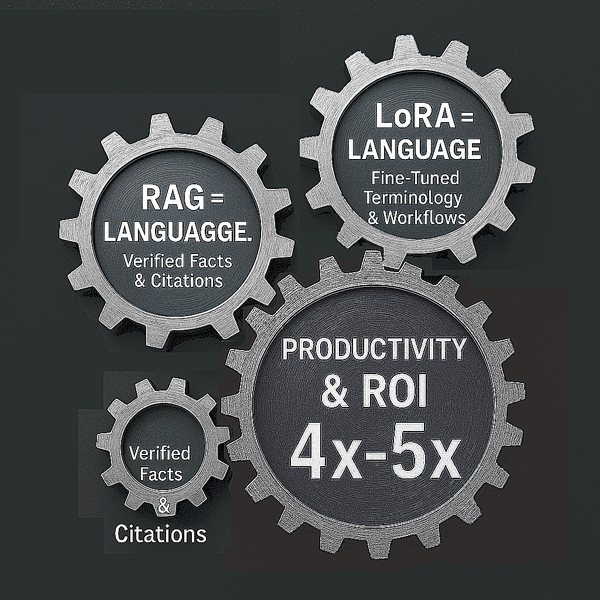Implementing AI In Construction - Where To Start
If you run or manage a construction company - actually, if you have a pulse and a warm body - you've heard people say that “AI is changing everything.”
The truth is more practical: it's changing some very specific things that help you keep projects on time, on budget, and remove stress from field and office work. This guide explains how affordable voice AI, RAG/LoRA knowledge assistants, and natural language reporting deliver measurable productivity gains and up to 4x ROI, turning project files into a verifiable, hands-free knowledge engine.
The difference between now (October 2025) and a year ago is that there are practical AI tools that small and medium-size builders can afford.
In this AI in Construction guide we bring together three key perspectives from our experience : how to decide what AI solution is right for your company, how to build it, and how to measure ROI.
This practical guide explains what that means in the field - how to get ready, how to build your own system, and how to measure the payoff.
Along the way, you will see how RAG (Retrieval-Augmented Generation, see Custom RAG Solutions: Beyond Basic Chatbots), LoRA (Low-Rank Adaptation, see LoRA Fine–Tuning: Smarter, Cheaper AI Models Trained On Your Data), and on-device voice-to-text (see see Voice–Enabled Mobile Apps Powered By AI ) turn everyday project files into a practical knowledge engine that construction can talk to - naturally, hands-free, and even offline.
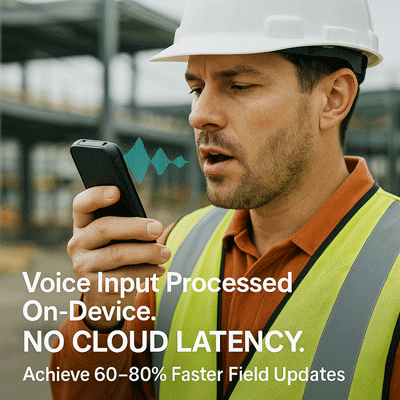
AI Applications In Constructions: What Is Commonly Discussed
AI has a potential of automating construction workflow in many different areas. Some of AI applications in construction that are commonly discussed are:
- Generative design and planning AI system can analyze design requirements, materials, and cost data to automatically generate optimized building layouts and project plans. It helps teams explore multiple design options quickly while balancing cost, performance, and sustainability.
- Automated estimating and bidding Machine learning models can read blueprints and past project data to produce faster, more accurate cost estimates and identify potential budget risks - reducing human error and improving bid competitiveness.
- Project scheduling and resource optimization AI scheduling tools can monitor progress and automatically adjust timelines and crew assignments when delays, weather events, or supply issues occur - keeping projects on track with minimal manual intervention.
- Job site monitoring and tracking progress of construction projects Drones and fixed cameras powered by computer vision analyze site images to measure completed work, detect safety hazards, and verify quality. Managers get real-time visibility into field operations without constant site visits.
- Predictive maintenance AI can analyze sensor data from heavy machinery to forecast maintenance needs before breakdowns happen - reducing downtime and extending equipment life.
- Safety monitoring and risk prevention Computer vision and pattern recognition systems detect unsafe behaviors or missing PPE, issuing instant alerts that help prevent accidents and ensure compliance with safety regulations.
While these AI technologies are powerful, many of them require significant investment in hardware, software, and custom integrations - making them better suited for large construction enterprises. But these are not the only ways for construction companies to benefit from AI. Small and mid-sized contractors can gain substantial advantages from practical AI solutions built around natural language processing (NLP), voice recognition, and intelligent data access. These NLP tools are faster to implement, require minimal setup, and often deliver measurable ROI within the first year.
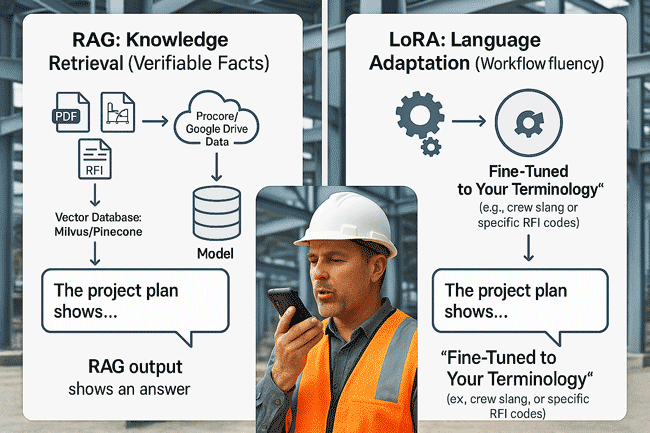
Practical AI / NLP Solutions That Boost Productivity for Construction Teams
Built on natural language processing (NLP) and voice AI, these practical AI solutions bring automation and instant insights to construction workflows - improving speed, accuracy, and projects delivery from day one.
Voice AI for Construction Site Field Teams
Hands-free mobile apps for efficient field workHow it works
Voice AI apps turn regular speech into structured, usable data for construction workflows. Field teams simply talk to a mobile app to log materials, check inventory, request info and drawings, record work progress, or fill out "paperwork" without typing or filling out physical forms. The system uses on-device voice recognition and natural language processing (NLP) to interpret spoken requests, then connects securely to the company's cloud platform to store or retrieve information in real time. Voice AI works fast and hands-free, keeping field teams productive, accurate, and connected.
Why it matters
Voice AI replaces repetitive data entry with simple conversation. Updates happen 60–80 percent faster, field notes are more complete, and fewer details get lost between the jobsite and the office. Supervisors see progress immediately, reports reach the cloud without delay, and compliance records are always current. It is an efficient, practical way to keep everyone informed - without changing the way construction teams already work.
Key benefits of Voice AI apps for construction
- Hands-free updates that keep work moving
- Accurate, GPS and time-stamped data from the field
- Real-time job progress visibility for managers and clients
- Better, faster and more accessible safety and quality documentation
- Easy deployment on existing mobile devices and use in the field
AI Knowledge Assistants Based On Company Data
Get info fast with natural language queriesHow it works
An AI Knowledge Assistant uses your own company data to answer questions, explain procedures, and provide quick access to information that normally requires searching through documentation, manuals or emails. It connects securely to approved sources - such as manuals, SOPs, project files, support tickets, and databases - and transforms them into vector embeddings stored in a private database optimized for semantic search. When employees ask a question, the AI assistant searches only that authorized content, identifies the most relevant information, and generates a clear, human-like response. Access is strictly managed by your organization, with role-based permissions and encryption ensuring that confidential data always remains protected.
Why it matters
Instead of searching documentation and manuals or asking coworkers for the same answers, team members get instant, consistent information from one trusted source. Field crews can confirm procedures or specs on their mobile phones, while office staff can check policies or submittal details on the office computers in seconds. The result is fewer mistakes, faster work completion, and less interruptions.
Key benefits of AI knowledge assistants for construction companies
- Instant answers from internal documents and systems
- Reduced dependency on help desks and supervisors
- Consistent information across all projects and teams
- Secure, role-based access with full data ownership
- Faster training and onboarding for new staff
Natural Language Reporting
Get reports you need by simply asking a questionHow it works
Natural language reporting lets managers and team members get real-time insights by simply asking questions in plain English. The AI system converts natural language requests into optimized SQL commands (Text-to-SQL) and pulls data directly from your company database. Users can ask things like "Show total materials used this week" or "List open tasks by location" and instantly receive accurate results, tables, or charts that update dynamically.
Why it matters
This approach removes the barrier between people and the data. Instead of waiting for reports to be prepared, decision-makers can check status, costs, or usage at any time. The result is faster decisions, fewer communication delays, and a clear picture of what is happening across multiple construction sites and projects.
Key benefits of natural language reporting for construction
- Real-time answers to business questions
- Accessible analytical reports providing exact info the user needs
- Fewer delays in communication and approval cycles
- The system works securely with existing databases and permissions
- Increased transparency and confidence in project data
AI Implementation In Construction - Early ROI Snapshot
From what we've seen, most firms start seeing results from AI / NLP tools implementation in just a few months. There are fewer errors, faster work completion, and better access to data and documentation. Even one prevented rework often covers the initial AI project cost. Typical AI system pilots run $6,000–$10,000 and return $20,000+ per year in saved labor and reduced delays.
The specific Benefits of Practical AI for SMBs that drive this return include:
- Work Smarter (Improving Productivity)
- Simplify Processes (Automating Workflows)
- Reduce Errors (Improving Accuracy)
- Make Better Decisions (Data-Driven Insights)
| Area | AI / NLP Solution | Result |
|---|---|---|
| Field Data Entry | Voice AI | 60–80% faster updates |
| Knowledge Access | RAG + LoRA | Fewer RFIs, quicker answers |
| Reporting | Text-to-SQL | Hours saved per report |
| Collaboration | Natural Language Interface | Unified communication |
Start small - choose one friction point and let the value prove itself. Once data and process pipelines are working, expanding to new use cases becomes simple.
AI Under the Hood (for the Curious)
You can skip this part if you just want the results.
Large language models like ChatGPT, Copilot, or Gemini know everything - except your business. RAG links your own documents to a model so answers come from verified facts. LoRA fine-tunes that model with your terminology and workflows. Voice-to-text runs locally on mobile devices, processing speech instantly and privately - no round-trip to the cloud, no latency, and no dependency on signal strength.
From AI / NLP Pilot to Productivity
Success starts with a clearly defined workflow - not “automate everything,” but one loop that produces daily value. For many contractors, that first loop is a schedule-change assistant, a voice-assisted inventory system, or an RFI/submittal writer.
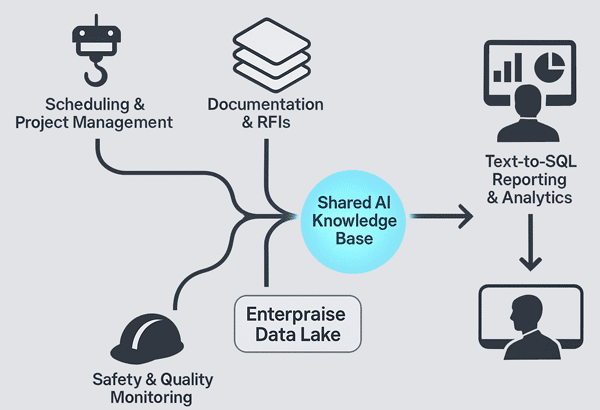
A typical three-month rollout:
- Weeks 1–2: Clean and index project documents.
- Weeks 3–4: Build a small RAG prototype so staff can “ask the spec.”
- Weeks 5–8: Gather examples, train a LoRA adapter, deploy combined system on one live project.
- Weeks 9–12: Evaluate results, measure accuracy and response time, and plan expansion.
The payoff shows immediately: fewer idle crews, RFIs drafted in minutes, fewer safety incidents, and higher equipment utilization. Every saved hour moves you closer to a more profitable job.
Making AI System Reliable
A dependable AI system runs on discipline. Hybrid retrieval combines keyword and semantic search to match both wording and intent. Version control ensures the model never references outdated specs. Role-based access limits who sees what, and audit logs trace every query and source.
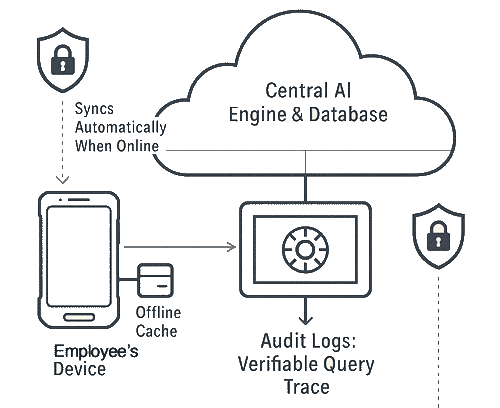
For jobsites with weak connectivity, offline caching keeps the assistant available anywhere and syncs automatically when back online.
AI Payoff: Financials, ROI, and Scaling Up
When owners ask what matters most, the answer is simple: productivity. AI’s payoff comes from people spending less time waiting, searching, or correcting mistakes - and more time building. The AI in construction market is expected to grow from $3.99 billion to $11.85 billion by 2029 (a CAGR of 24.31%). Furthermore, professionals believe AI can improve progress monitoring and project scheduling by approximately 36%.
A modest $7,000 – $8,000 pilot using RAG and LoRA typically yields $25,000+ in annual savings. Hardware runs on a local GPU workstation or small cloud VM; storage costs a few hundred dollars a year; document ingestion into the system is about a $1000, LoRA fine-tuning costs less than a lost workday.
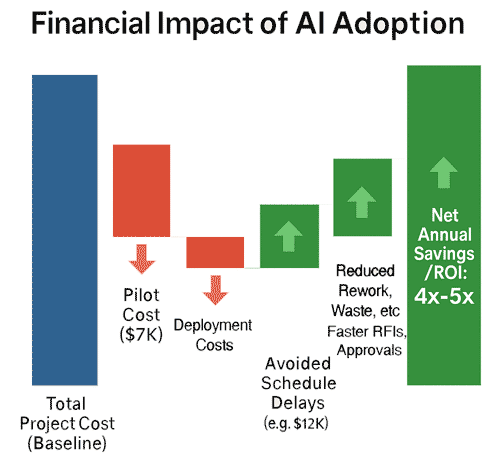
| Source of Value | Before AI | After AI | Savings / Project | Evidence Source |
|---|---|---|---|---|
| Schedule slippage | 14 days avg delay | 8 days | $12,000 + labor & liquidated damages avoided | Based on pilot contractor benchmarks |
| RFI draft & review | 3 h each | 45 min | $250 / RFI × 20 = $5,000 | [1], [2], [3] |
| Safety incidents | 6 per year | 3 | Insurance reduction ≈ $3,000 | [1] |
| Equipment downtime | 10% idle | 7% | $4,000 maintenance efficiency | [4], [5], [6] |
| Estimating effort | Full week | 1 day | $6,000 labor saved | [7] |
| Total Estimated Annual Gain | ≈ $30,000 – $35,000 |
[1] Shawmut AI Safety Initiative: “Shawmut Design & Construction Uses Newmetrix’s ‘Vinnie’ AI Platform to Identify Leading Risk Indicators,” Newmetrix Case Study, 2022. https://www.newmetrix.com/customers/shawmut-design-and-construction
[2] Business Insider: “Shawmut Construction Is Using AI to Predict Safety Incidents Before They Happen,” Business Insider, March 2023.
[3] Buildots: “Using Buildots to Reduce Delays by up to 50% — How Automated Progress Tracking Is Changing Construction,” Buildots Blog / Case Studies, 2024. https://www.buildots.com/resources/case-studies
[4] Volvo Construction Equipment: “ActiveCare Direct Delivers Proactive Uptime Management,” Volvo CE Case Study, 2023. https://www.volvoce.com/global/en/news-and-events/press-releases/activecare-direct-case-study
[5] Volvo CE Fleet Uptime Center: “How Predictive Maintenance Keeps Fleets Working and Downtime Low,” Volvo Construction Equipment Uptime Center, 2022. https://www.volvoce.com/global/en/services/uptime-center
[6] Caterpillar Telematics: “Predictive Maintenance Reduces Downtime for Cat Equipment Fleets,” Caterpillar Industrial IoT Case Study, 2021. https://www.cat.com/en_US/by-industry/technology/predictive-maintenance.html
[7] Togal.AI: “Coastal Construction Saves 14.5 Hours Per Plan Set Using Togal.AI,” Togal.AI Customer Story, 2023. https://www.togal.ai/case-studies/coastal-construction
If schedule delays shrink from two weeks to one, that alone saves roughly $12,000 in labor and liquidated-damage exposure. Faster RFIs, predictive maintenance, and better documentation reduce costs further. ROI formula: (Savings − Cost) / Cost ≈ 4×–5× in the first year. Most pilots break even within a quarter.
The intangibles matter too:
- Field teams waste fewer hours chasing answers.
- Office handles fewer repetitive forms.
- Clients see faster, clearer communication.
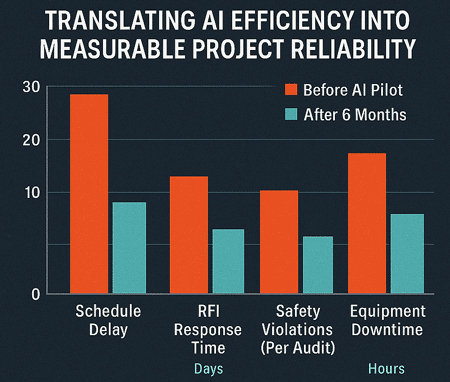
Each document that passes through the system strengthens the next project - a continuous virtuous feedback loop that keeps building your company’s knowledge base. Scaling up follows a steady rhythm: one project proves the model, the next adds safety and estimating, and soon all active projects share the same AI backbone. Within a year, reports, schedules, and forecasts merge into one searchable source of truth.
Lessons from Early AI Adopters
Early adopters tell a consistent story: Start with one well-defined pilot. Keep the interface simple. Involve supervisors early. Review AI outputs weekly for accuracy and tone. Record every improvement - a day saved, a delay prevented, a rework avoided. Those numbers build trust and justify scaling. Over time, the AI becomes part of the crew - reliable, quick, and tuned to how the company actually works.
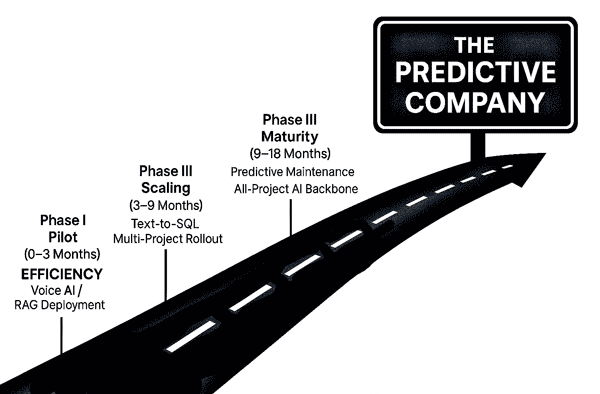
Bottom Line
AI in construction isn’t about replacing people - it’s about giving every crew, estimator, and project manager faster access to the knowledge they already built. With voice-to-text capability that works even when the internet doesn’t, that knowledge is only ever a sentence away.
Frequently Asked Questions
- 1. How is AI / NLP used to improve productivity in construction?
- AI / NLP improves construction site productivity primarily through Voice AI apps for field teams (leading to 60–80% faster updates), RAG/LoRA Knowledge Assistants (fewer repeated questions, quicker answers), and Text-to-SQL reporting (instant visibility for managers), enabling field teams to work hands-free and access project knowledge instantly.
-
- 2. How exactly voice AI apps work on construction sites?
- Voice AI apps turn spoken commands into real-time actions on the job site. Crew members can talk to a mobile app to record material usage, access info and drawings, check inventory, fill out paperwork, send job site reports, and more - quickly and reliably, without stopping their work. The app uses speech recognition and natural language processing(NLP) to understand what is being said, then connects to the company's cloud system to store or retrieve data instantly. Because it works hands-free and can function offline, Voice AI keeps field teams productive, accurate, and connected.
-
- 2. How exactly voice AI apps work on construction sites?
- Voice AI apps turn spoken commands into real-time actions on the job site. Crew members can talk to a mobile app to record material usage, access info and drawings, check inventory, fill out paperwork, send job site reports, and more - quickly and reliably, without stopping their work. The app uses speech recognition and natural language processing(NLP) to understand what is being said, then connects to the company's cloud system to store or retrieve data instantly. Voice AI works fast and hands-free, keeping field teams productive, accurate, and connected.
-
- 3. How does AI internal knowledge assistant works, and how does it get access to our company internal data?
- An AI internal knowledge assistant uses advanced natural language processing (NLP) and retrieval-augmented generation (RAG) to provide instant, context-aware answers about your company's internal processes, documents, and data. It connects securely to approved sources - such as manuals, SOPs, project files, support tickets, and databases - and transforms them into vector embeddings stored in a private database optimized for semantic search. When employees ask a question, the AI assistant searches only that authorized content, identifies the most relevant information, and generates a clear, human-like response. Access is strictly managed by your organization, with role-based permissions and encryption ensuring that confidential data always remains protected.
-
- 4. What is the estimated Return on Investment (ROI) for an AI pilot in construction?
- Typical AI pilots run $6,000–$10,000 and consistently yield $25,000+ per year in annual savings by reducing delays and errors. This results in an ROI of approximately 4x–5x in the first year, with most pilots achieving a break-even point within the first quarter.
-
- 5. What are the biggest benefits of adopting practical AI for small and medium construction businesses (SMBs)?
- Practical AI helps small and medium construction companies work smarter without adding complexity. By automating routine construction project tasks - data entry, documentation, materials tracking, job site reporting, and scheduling - AI system saves time and reduces costly errors. Voice-enabled and mobile AI tools let field crews capture information hands-free, while AI analytics give managers real-time visibility into project progress, equipment usage, and job costs. Unlike large-scale enterprise systems, practical AI systems are affordable, quick to deploy, and tailored to everyday construction workflows, helping SMBs improve productivity, accuracy, and decision-making.
